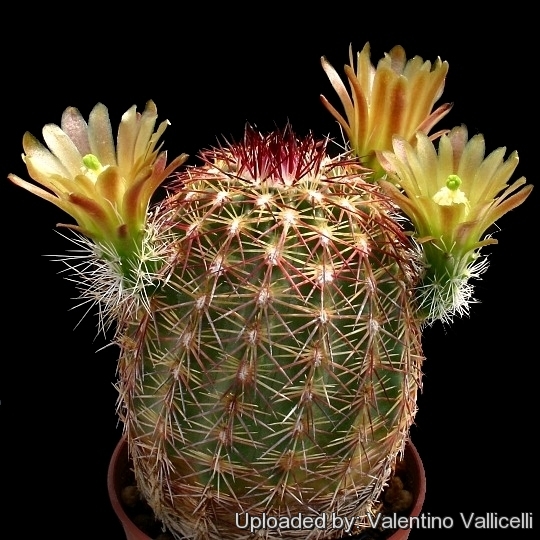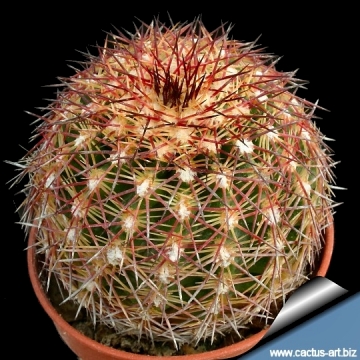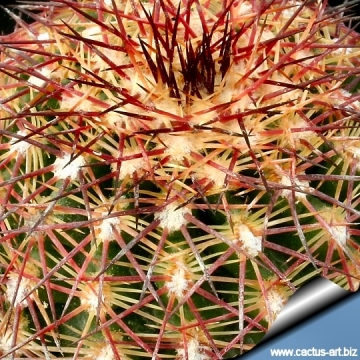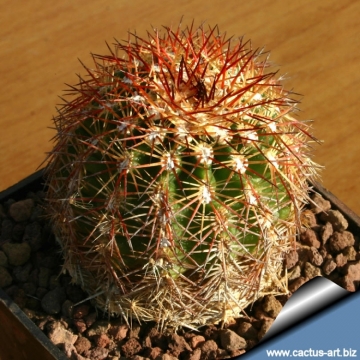Accepted Scientific Name: Echinocereus viridiflorus subs. cylindricus (Engelm.) N.P.Taylor
Cactaceae Consensus Init. 3: 10. 1997

Cereus viridiflorus var. cylindricus (Echinocereus viridiflorus subs. cylindricus) Photo by: Valentino Vallicelli
It is native from a narrow band stretching from the Big Bend of Texas and Mexico to southern New Mexico. El Paso habitat: mainly in the Franklin Mts.
Origin and Habitat: It is native from a narrow band stretching from the Big Bend of Texas and Mexico to southern New Mexico. El Paso habitat: mainly in the Franklin Mts.
Synonyms:
See all synonyms of Echinocereus viridiflorus
Common Names include:
ENGLISH: Green-flowered Pitaya
Description: Usually grows singly or forms two or more stems , but never forms large clusters or mounds.
Stems: as much as 7,5 cm in diameter and 15 (25) cm tall.
Spines: This species show the extreme variability in spine colour (white, yellow, brown, reddish, black) some plants has only short radials while other have a variable number of centrals.
Flowers:** Smaller than others in this genus about 2,5 cm long and 2,5 cm inch broad. They vary from yellowish-green to dark-red or brownish, and grow well down on the sides, often forming a band around the middle. Blooms in March or April.
Fruit: The fruit is small about the size of a small grape, green at first and later turning a purplish red and spiny.
Remarks: Echinocereus chloranthusSN|11071]]SN|7768]] is part of the Echinocereus viridiflorusSN|7768]]SN|11071]] compless*** that comprises a large number of infraspecific taxa, differing in various combinations of flower color, spine color, number and thickness of central spines, and other characters, including floral scent. Wherever such taxa are sympatric they intergrade; all are freely interfertile in the greenhouse. Among them:
More...Subspecies, varieties, forms and cultivars of plants belonging to the Echinocereus viridiflorus/russanthus complex
 Echinocereus carmenensis W.Blum, Mich.Lange & E.Scherer in W.Blum et al.: has stocky body covered by tight yellowish pectinate spines and peculiar chocolate-scented flowers. Distribution: La Cuesta, passo Sierra del Carmem, Coahuila, Mexico.
Echinocereus carmenensis W.Blum, Mich.Lange & E.Scherer in W.Blum et al.: has stocky body covered by tight yellowish pectinate spines and peculiar chocolate-scented flowers. Distribution: La Cuesta, passo Sierra del Carmem, Coahuila, Mexico. Echinocereus milleri W.Blum, Kuenzler & Oldach: has the "hairy" seedlings of Echinocereus viridiflorus var. neocapillus, but has fewer spines it is also similar to the yellow spined Echinocereus viridiflorus subs. Correllii (which it obviously is not).
Echinocereus milleri W.Blum, Kuenzler & Oldach: has the "hairy" seedlings of Echinocereus viridiflorus var. neocapillus, but has fewer spines it is also similar to the yellow spined Echinocereus viridiflorus subs. Correllii (which it obviously is not). Echinocereus russanthus D.Weniger: has spheric to cylindrical stems, 8-30 tall and 4-8 cm Ø; ribs 10-20. Spines: Interlocking, bristly, typically reddish to brown, radiating in all directions. Distribution: Chihuahua (Mexico) and N-W Texas (USA).
Echinocereus russanthus D.Weniger: has spheric to cylindrical stems, 8-30 tall and 4-8 cm Ø; ribs 10-20. Spines: Interlocking, bristly, typically reddish to brown, radiating in all directions. Distribution: Chihuahua (Mexico) and N-W Texas (USA). Echinocereus russanthus f. cristata hort.: crested form.
Echinocereus russanthus f. cristata hort.: crested form. Echinocereus russanthus subs. fiehnii (Trocha) W.Blum & Mich.Lange: Distribution: endemic to the Sierra del Nido, central Chihuahua, Mexico.
Echinocereus russanthus subs. fiehnii (Trocha) W.Blum & Mich.Lange: Distribution: endemic to the Sierra del Nido, central Chihuahua, Mexico.- Echinocereus russanthus subs. weedinii Leuck ex W.Blum & Mich.Lange in W.Blum et al.
 Echinocereus viridiflorus Engelm. in Wisliz.: ssp. viridiflorus (Typical form) With small stems and relatively pure yellow flowers, extends from central New Mexico and the Texas Panhandle to South Dakota.
Echinocereus viridiflorus Engelm. in Wisliz.: ssp. viridiflorus (Typical form) With small stems and relatively pure yellow flowers, extends from central New Mexico and the Texas Panhandle to South Dakota. Echinocereus viridiflorus var. canus A.M.Powell & Weedin: has hairy juvenile forms. Distribution: Solitario, Sandstone ridge above Righthand Shutup, Presidio Co., Texas, USA.
Echinocereus viridiflorus var. canus A.M.Powell & Weedin: has hairy juvenile forms. Distribution: Solitario, Sandstone ridge above Righthand Shutup, Presidio Co., Texas, USA. Echinocereus viridiflorus subs. chloranthus (Engelm.) N.P.Taylor: has 10-18 ribs, 5 or more central spines, giving the plants a bristly appearance, it is often considered a separate species (Echinocereus chloranthus). Distribution: W. Texas, S.E. New Mexico, and N. Mexico.
Echinocereus viridiflorus subs. chloranthus (Engelm.) N.P.Taylor: has 10-18 ribs, 5 or more central spines, giving the plants a bristly appearance, it is often considered a separate species (Echinocereus chloranthus). Distribution: W. Texas, S.E. New Mexico, and N. Mexico. Echinocereus viridiflorus subs. correllii (L.D.Benson) W.Blum & Mich.Lange in W.Blum et al.: It is a poorly defined, yellow-spined population near Marathon, Texas.
Echinocereus viridiflorus subs. correllii (L.D.Benson) W.Blum & Mich.Lange in W.Blum et al.: It is a poorly defined, yellow-spined population near Marathon, Texas. Echinocereus viridiflorus cowperii n.n.: same as: Echinocereus viridiflorus var. rhyolithensis.
Echinocereus viridiflorus cowperii n.n.: same as: Echinocereus viridiflorus var. rhyolithensis. Echinocereus viridiflorus subs. cylindricus (Engelm.) N.P.Taylor: The common morphotype grows at middle altitudes in Texas and southeastern New Mexico, it has 0-2(-3) central spines.
Echinocereus viridiflorus subs. cylindricus (Engelm.) N.P.Taylor: The common morphotype grows at middle altitudes in Texas and southeastern New Mexico, it has 0-2(-3) central spines. Echinocereus viridiflorus subs. davisii (Houghton) N.P.Taylor: In the broad sense Echinocereus viridiflorus may prove paraphyletic with respect to Echinocereus davisii, but they are phenologically isolated, with Echinocereus davisii flowering earlier and thus appearing reproductively isolated in the wild.
Echinocereus viridiflorus subs. davisii (Houghton) N.P.Taylor: In the broad sense Echinocereus viridiflorus may prove paraphyletic with respect to Echinocereus davisii, but they are phenologically isolated, with Echinocereus davisii flowering earlier and thus appearing reproductively isolated in the wild. Echinocereus viridiflorus subs. davisii cv. brevispinus hort.: has very short spines, usually radial, pectinated, stout, fang like, white whit a dark contrasting tip 2-4 mm long. Spine clusters looks like small starfishes.
Echinocereus viridiflorus subs. davisii cv. brevispinus hort.: has very short spines, usually radial, pectinated, stout, fang like, white whit a dark contrasting tip 2-4 mm long. Spine clusters looks like small starfishes. Echinocereus viridiflorus var. montanus hort.: has significantly depressed stems solitary or in low clusters (mostly less than 2 cm tall). Distribution: Southwestern USA (Monarch Pass, Colorado?)
Echinocereus viridiflorus var. montanus hort.: has significantly depressed stems solitary or in low clusters (mostly less than 2 cm tall). Distribution: Southwestern USA (Monarch Pass, Colorado?) Echinocereus viridiflorus var. neocapillus (D.Weniger) A.D.Zimmerman: Remarkable for its softly hairy, not sharply spiny, seedlings.
Echinocereus viridiflorus var. neocapillus (D.Weniger) A.D.Zimmerman: Remarkable for its softly hairy, not sharply spiny, seedlings.- Echinocereus viridiflorus var. rhyolithensis W. Blume & Mich.Lange: (Echinocereus russantus forma) Bristly red-spined plants from New Mexico.
 Echinocereus viridiflorus var. robustior Kuenzler: It is a more robust form but not sufficiently differentiated and considered merely a local variant of Echinocereus viridiflorus var viridiflorus. Distribution New Mexico.
Echinocereus viridiflorus var. robustior Kuenzler: It is a more robust form but not sufficiently differentiated and considered merely a local variant of Echinocereus viridiflorus var viridiflorus. Distribution New Mexico.
Bibliography: Major references and further lectures
1) David Hunt, Nigel Taylor “The New Cactus Lexicon” DH Books, 2006
2) John Pilbeam (1999) “Mammillaria The Cactus File Handbook” Nuffield Press.
3) Edward F. Anderson “The Cactus Family” Timber Press, 2001
4) James Cullen, Sabina G. Knees, H. Suzanne Cubey “The European Garden Flora Flowering Plants: A Manual for the Identification of Plants Cultivated in Europe, Both Out-of-Doors and Under Glass”Cambridge University Press, 11/ago/2011
 Cereus viridiflorus var. cylindricus (Echinocereus viridiflorus subs. cylindricus) Photo by: Cactus Art
Cereus viridiflorus var. cylindricus (Echinocereus viridiflorus subs. cylindricus) Photo by: Cactus Art Cereus viridiflorus var. cylindricus (Echinocereus viridiflorus subs. cylindricus) Photo by: Cactus Art
Cereus viridiflorus var. cylindricus (Echinocereus viridiflorus subs. cylindricus) Photo by: Cactus Art Cereus viridiflorus var. cylindricus (Echinocereus viridiflorus subs. cylindricus) Photo by: Cactus Art
Cereus viridiflorus var. cylindricus (Echinocereus viridiflorus subs. cylindricus) Photo by: Cactus ArtSend a photo of this plant.The gallery now contains thousands of pictures, however it is possible to do even more. We are, of course, seeking photos of species not yet shown in the gallery but not only that, we are also looking for better pictures than those already present.
Read More... Cultivation and Propagation: In culture E. chloranthus v. cylindricus is without problems and regularly shows its small greenish to brick-red coloured flowers if we provide an adequate winter rest period. It is sensitive to overwatering (rot prone) needs good drainage, Keep drier and cool in winter. Need full sun; Very cold resistant hardy to -10° C or less for short periods of time.
Propagation: Seeds or cutting (if available)













